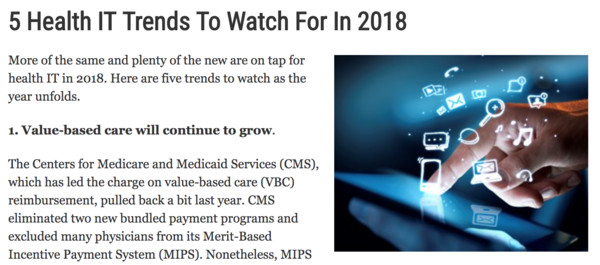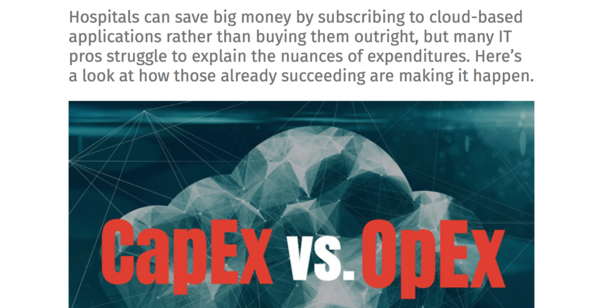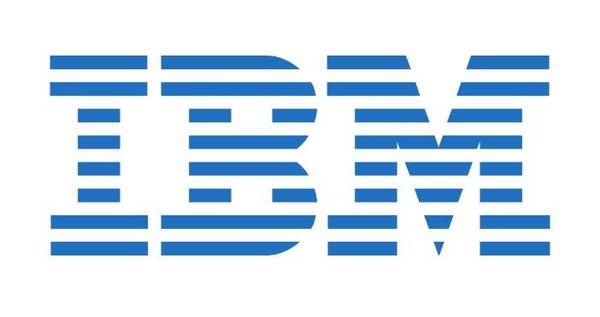January 2018 Archives
Jan 15, 2018

EHRs: The Good and the Bad
In the past, medical transcription used to be easier. A doctor dictated exam outcomes on the fly, and a transcriptionist typed it into the patient record immediately. This allowed doctors to focus on patients while still recording data.
Then, electronic health records (EHRs) came into the picture. EHRs were intended to be a way to better track health data for hospitals, payers and physicians. Although they have good intentions, they often end up causing more problems than they solve.
According to a study by Northwestern University, physicians who have EHRs in their exam rooms spend around 33% of their time looking at their computer screens, while doctors who use paper charts spend only 9% of their time looking at screens.
Also, EHRs can store massive amounts of data, which is a double-edged sword because though data is important, the structure of that data creates challenges. On one hand, it is too limiting. Doctors can enter information about a patient's medical history, medications and procedures--but only through constrained check boxes that don't capture nuances and complexities.
While unstructured "notes" sections can be included in comment boxes, there is no standard format for how these should be written, and it is hard to pull insights without diving into detail. Furthermore, this data is often copied and pasted repeatedly into different areas within the EHR, resulting in a phenomenon called "note bloat," when there's so much information it's difficult to make good use of it.
Where Does Blockchain Technology and AI Come In?
Blockchain technology (and apps built on a blockchain) can make data organized and easily accessible, while artificial intelligence makes it possible to extract intelligent insights from vast amounts of data that no human could ever analyze.
Blockchain is a digital ledger that records and shares transactions and interactions in chronological order, providing security and interoperability for healthcare providers and their patients. In healthcare, for example, each patient visit, diagnosis, prescribed treatment, outcome and other key data that goes in the EHR are considered the transactions. Various providers, payers and pharmacies all record this information on the same ledger for a given patient, and they can access the data put there by each other. For example, medications can be noted, assessed and managed to prevent contradictions or misuse.
The apps that can be built on the blockchain further help with parsing and reading data that is logged but with details stored separately--in a PDF, for example. It's worth noting that blockchains for health data can and should be created as a permissioned ecosystem of trusted collaborators with additional controls that protect personally identifiable information while allowing anonymized sharing of personal health information.
Using the database, providers and specialists who see patients for the first time can rest assured that the data regarding previous tests, diagnoses and treatments is accurate. Having highly reliable patient data on the ledger means providers can spend less time on repetitive data entry tasks, prevent catastrophic misdiagnoses and provide better predictive solutions to patients. Furthermore, this data is now much more consumable by intelligent algorithms.
For example, California-based startup PokitDok is using blockchain to develop application programming interfaces (APIs) for the healthcare industry in areas such as identity management, claims and pharmacy in order to create a more secure network for accessing and sharing patient data. It also uses machine learning to analyze large amounts of data and speed up processes--for instance, it's able to run an eligibility check on an insurance claim in just seconds rather than days, saving healthcare providers time and money.
Once the data is organized in a transparent and fully reliable way on a blockchain, machine learning and eventually artificial intelligence (AI) can learn from the patterns in the data and execute analyses very quickly.
Digital Reasoning is a startup that's using AI to help healthcare professionals make better decisions. It uses complex algorithms to organize data into graphs and detect patterns, helping machines "think more like people do." As a result, doctors are able to see a clearer picture of a patient's health and make more informed decisions based on all that information.
Complications Within Interoperability
The industry mindset around sharing data has typically been very conservative, even antagonistic. However, over the past two years, new standards like fast healthcare interoperability resources (FHIR) are leading to more sharing--35% of U.S. hospitals plan to use open APIs within the next year, and that data is their competitive advantage. In order to truly provide value to patients, though, this trend needs to continue and extend to all players in the continuum of patient care.
Healthcare systems experts understand the importance of providers being able to collaborate, even when they don't know one another. The trouble is that interoperability in healthcare is complicated by a variety of factors.
Because providers all operate within their own systems, identifying who previously treated a patient, as well as when and where treatment took place, can be difficult. Also, EHRs may be moved into health information exchanges, but they are still controlled by data silos. Patients cannot choose what specific data of theirs is shared. To prevent unwanted access, they may put a blanket denial on any of their health information being shared.
Together, these factors (and many others) make interoperability a vital but difficult-to-achieve goal for healthcare systems. Therefore, one of the biggest reasons blockchain is becoming such a popular healthcare buzzword is because it may be the solution to making safe and efficient interoperability possible. And from there, with the application of AI, major innovation will accelerate.
The Challenges to Implementing Blockchain and AI
Despite all the problems blockchain and AI can solve for doctors, hospitals and patients, they're not without their challenges. Blockchain must resolve problems related to scalability, and AI faces the challenge of getting doctors on board.
With AI, doctors will need to believe in the technology and trust that it's analyzing the data accurately. Doctors will still be the ones diagnosing patients and providing treatment plans, but if they don't trust the information they're receiving from AI technology, they won't be able to do their jobs to the best of their ability.
At the end of the day, humans want to be cared for by other humans--not robots. But doctors are spending far too much time inputting information into EHRs rather than spending time with their patients. Blockchain and AI won't be able to take over all of doctors' responsibilities, but they can help them get back to what they love: helping people be healthy and heal.
Source: Modern Medicine Network (View full article)
Dan Corcoran | Permalink | Comments (0)
Jan 15, 2018

Trinitas Regional Medical Center in Elizabeth, New Jersey, was an early EHR adopter starting with a product called TDS back in the 1980s. It was popular with university hospitals and other pioneers who were among the first to move from paper files to digital records.
There were patient lists then, said Trinitas CIO Judy Comitto: "Orders were entered, meds were entered, and we just moved along with the flow."
Over multiple iterations of the technology, TDS morphed into what tech teams recognize today as Allscripts Sunrise Clinical Manager.
"We've been a customer that long," Comitto said. "It's changed quite a bit, but we've moved patient records starting with the TDS of the '80s, and rolled them into Sunrise years ago. We have cultivated talent in the product. We have been on it so long, we have grown resources - dedicated resources that are really skilled."
Comitto recognizes an inclination for teamwork and an atmosphere where respect and cooperation reign as key drivers for excellence at Trinitas, a 554-bed health system that includes a 120-bed long-term care center.
"When people are respectful and cooperative, there's always a willingness to go the extra mile for each other," she said. "People work in teams well. It's been the modus operandi for years. I think that's very much appreciated by the 2,600 employees who work here."
The employees are also recognized for their achievements, she added. They know their work has been noticed - and appreciated. Employees also support one another in personal ways, Comitto said.
For example, they contribute to funds earmarked for helping families of work associates who are in personal crises. Everyone donates and those funds are disbursed by a committee which reviews requests. The money goes to helping fellow employees who have home fires or healthcare issues, for instance.
Comitto said the IT team is always on the lookup for acquiring or building new tools to boost quality and flexibility.
Telehealth is a prime example. "We have a stroke neurology telehealth product - bringing those tools into the neurology group to do quick assessments of patients in our ED."
On the hiring front, one of Comitto's favorite question for prospective employees is: "If you were able to achieve your dreams what would you be doing?" Some people know right off the bat, others waver.
Some candidates aren't interested -- others want to be CIO.
Dan Corcoran | Permalink | Comments (0)
Jan 15, 2018

As government reimbursement shrinks, and hospital and practice margins grow tighter, the demand for better revenue capture grows stronger as well. That's according to a new report from Future Market Insights, which has predicted that the global market for healthcare revenue cycle management software will reach $ 43.3 billion by the end of 2022. During the forecast period, 2017-2022, the global healthcare revenue cycle management software market is projected to soar at a compound annual growth rate of 6.9 percent.
The largest end-user of healthcare revenue cycle management software is expected to be in hospitals, but its use is projected to rise in clinics and laboratories as well. In fact, labs are estimated to have contributed a nearly one-fifth share of global revenues in 2017 and the end-use of healthcare revenue cycle management software in clinics is expected to net nearly $6.5 billion.
The report showed growing demand in several supporting areas, including services facilitating revenue cycle management for healthcare settings, saying that in 2017, more than half of revenues taken in the global healthcare revenue cycle management software market will be for services. Moreover, healthcare-RCM services are pegged to gain traction in terms of adoption and inadequate numbers of trained staff and a rise in downcoding an RCM service are expected to fuel a boost in the buying of healthcare revenue cycle management as a service.
Cloud-based products are proven to enhance resource acquisition, boost infrastructure reliability, and help consolidate operations. In terms of revenue cycle management software, cloud models increase flexibility and also enable transferability between two or more end-users. The data showed that these attributes parlayed into major dollars, with nearly $ 27 billion in revenue expected to come through cloud-based healthcare revenue cycle management software on a global basis.
"Taking the complex structure of revenue cycle management into account, cloud-deployment is also expected to save costs by offering proper alignment of actual usage and resource expenditure," the report said.
Billing and payment management applications of healthcare revenue cycle management software are also expected to spike with a CAGR of 8.2 percent during the forecast period. Specifically for the accounts receivable sector of revenue cycle management, demand is expected to increase and revenue from it is forecasted to net over one-fourth share of global revenues. However, claim management applications are slated to show slow revenue growth, racking up a little more than$ 5.84 billion in revenue by the end of 2022.
Leading developers of healthcare revenue cycle management software through 2022 include Cerner, McKesson, Quest Diagnostics, athenahealth, Epic Systems, EMC, CareCloud, Greenway Health, Allscripts and Qsi Management.
"The majority of these companies are expected to focus on removing conventional flaws and increasing security measures to protect valuable data managed by their offerings. Moreover, new market entrants are likely to face barriers in penetrating this highly-competitive market," the report said.
Source: Healthcare Finance (View full article)
Dan Corcoran | Permalink | Comments (0)
Jan 12, 2018

Telehealth Grows Up, And It's Powerful
Telehealth has already evolved from a sparse specialty offering into a robust, easily accessible and comprehensive engine; it changes the healthcare paradigm with the ability of robust and wide-ranging use cases, along with patients who now proactively seek out the convenient and trusted access. In 2018, the true power of virtual health delivery will be experienced by those systems that evolve from episodic care to include expansive clinical services ranging from expert second opinions for the most complicated medical conditions to the use of AI and predictive analytics to proactively identify patients in need of intervention. Rather than an isolated medical opinion or treatment option, these virtual offerings are integrated into the current healthcare ecosystem and provide access to the highest rated physicians, still providing patients with one single point of entry to the virtual care ecosystem.
Payers Raise Expectations, Unlocking The Full Value Of Virtual Healthcare Delivery
As employers, health plans, and health systems face escalating pressures for cost containment, access, and patient satisfaction, organizations will look even more to their virtual care provider to deliver solutions that tackle these needs head-on. Significant advancements in technology, analytics and care delivery offer unprecedented value that can be derived from virtual care delivery systems in the form of financial savings, engagement and satisfaction, and improved health outcomes.
Utilization Takes Center Stage As Digital Health Adoption Approaches Mainstream
As 90 percent of adults under the age of 65 have smartphones today, consumers are leveraging personal devices and remote services to take control of their healthcare journey at an increasing rate, embracing digital health in their everyday lives. In fact, research shows that two-thirds of Americans either have or are open to using mobile health apps to manage their health. From fitness trackers, to smart thermometers and virtual assistants, the prevalence of digital health among consumers has reached an inflection point. As consumer comfort with digital health gives way to reliance on these tools, telehealth will fill the care gap with far greater and more convenient access to quality care.
Virtual Healthcare Delivery Tackles The Largest Cost Drivers -- Finally
Diagnosing and treating chronic conditions and complex cases consumes roughly 84 percent of healthcare dollars in the U.S. alone. Through a powerful combination of analytics to pinpoint care needs, cognitive computing to ensure accuracy, and a single point of convenient access to leading specialists across the globe, virtual care delivery provides an innovative tool to address the escalating impact of chronic conditions and complex cases.
Mental Health Is Part Of The Conversation. Organizations Take Action
Mental health issues are costing American companies an estimated $23 billion per year in absenteeism. The good news is stigmas are being reduced and those in need are increasingly open to asking for help. Today's organizations are now recognizing that more substantial behavioral health solutions can vastly improve their workplace health. The U.S. Department of Health and Human Services estimates that approximately 96.5 million Americans live in areas where there are shortages of mental health providers. Behavioral virtual care solves that, enabling employees to get help and be on the path to wellness sooner. In 2018, continued advances in the delivery of virtual care for behavioral health will help to overcome geographical and societal barriers to quality care.
Health Systems Embrace Telehealth (At Scale)
As hospitals and health systems redefine the consumer experience to move toward value-based healthcare, telehealth has been identified as a key long-term solution for health systems to build their competitive market positioning and reduce financial risks. It's no surprise that 76 percent of health systems have or will be implementing consumer telehealth in some capacity by December 2018.
Data Security Is Front And Center, As Connected Care Accelerates
As connected devices from one's non-healthcare world increasingly make healthcare data portable - from smartphones storing medical records to announcements of health plan and technology companies partnering to drive behavior change - data security and integration have never been more important or high profile. The new year will see an even greater need for strong third-party validation of a virtual care provider's ability to meet healthcare regulations and requirements for securing the sensitive protected healthcare information of its clients and members.
Artificial Intelligence + Medical Excellence = High-Quality Care
The world is abuzz with renewed excitement about the potential artificial intelligence (AI) might have on healthcare transformation. Artificial intelligence presents a grand frontier for health care. Those who are able to truly succeed in this area and demonstrate improved outcomes with AI will be those who have identified how to successfully marry AI to medical excellence. Cognitive computing is only as good as the data that goes in and the experts that interpret what comes out. Without a foundation of medical quality, big data, analytics, and cognitive services fall short and could ultimately be misused in areas where mistakes are already far too prevalent.
Source: Health IT Outcomes (View full article)
Dan Corcoran | Permalink | Comments (0)
Jan 12, 2018

"In 2018 we're doubling down on blockchain," says Gil Beyda, managing director of Comcast Ventures, the investment arm of one of the world's largest media and telecom companies.
For the venture capital arm of Comcast, an investment in blockchain isn't opportunistic, Beyda insists. "Just to be clear, if bitcoin were at $15 instead of $15,000 we would still be committing to this," he said.
Comcast Ventures has been looking at blockchain technology for months, driven by Comcast and NBCUniversal's long-standing interest in applications across several of the company's business units.
In fact, internal experiments are already underway around advanced advertising alongside Disney and Cox Communications that will be used to match data sets without sharing consumer data. Other experiments are underway looking at applications around royalty tracking and energy, Beyda says.
"A lot of folks are trying to figure out how do you apply this consensus-driven immutable decentralized infrastructure and decentralized distributed applications," Beyda says. "We have real-world applications inside Comcast where folks are trying to solve real-world problems with blockchain."
Earlier this month, the company announced a commitment to MState Growth Lab, an accelerator program focused on enterprise blockchain startups that's also being funded by IBM and Galvanize, an accelerator, investment fund and bootcamp.
"In 2018, we will see a growing number of enterprise blockchain use cases go mainstream from healthcare applications to government, supply chain and retail to the real estate and transportation industries. But for most of these use cases to succeed, blockchain startups need to be able to engage well with enterprise customers. Our growth lab is going to help make that happen," said MState co-founder and CEO Rob Bailey.
Bailey is chief executive of MState program, which will be managed with assistance from the partners at Boldstart Ventures.
The $250,000 commitment that Comcast Ventures made to MState is only one in a series of experiments that the fund is trying as it wraps its head around the potential of blockchain for its businesses and as a startup investment opportunity.
The firm also has committed a few million dollars to a blockchain-focused fund as a fund-of-fund investment. And one of the firm's portfolio companies, YouNow, is following the "when in doubt, ICO," route.
Beyda says that Comcast Ventures is even discussing whether it will hold tokens or cryptocurrencies itself.
"As part of our move into blockchain technologies, we understand it's going to disrupt many different types of businesses and it may even disrupt traditional venture businesses, and we want to get in there and understand that," Beyda says.
Comcast Ventures invests across different classes, committing anywhere from $500,000 to $20 million in the companies it backs... and with its corporate parent, it can accelerate technologies and add scale to some of the blockchain applications that are currently in development, Beyda says.
Specifically for Comcast, blockchain technologies around royalty tracking, identity and digital rights management all sound appealing.
Other entertainment companies have already seen the value in blockchain startups. Last May, Spotify acquired the blockchain technology developer MediaChain to solve its music attribution problem.
The value of these applications are completely independent of the price of various cryptocurrencies, says Beyda.
"Irrespective of what's happening in cryptocurrency we think that this technology -- like database technology and internet technology were transformational -- this technology will also have a high area of growth and adoption," Beyda says.
While the company intends to make blockchain a priority, it's not going to be overly aggressive in its experiments with the technology.
"We're going to take a staged approach," says Beyda. "We're going to first try to make equity investment in these technologies and evaluate what our token position would be moving forward. We're just trying to understand what are the implications in regard to governance and other issues."
Source: TechCrunch (View full article)
Dan Corcoran | Permalink | Comments (0)
Jan 12, 2018

[...]While health IT tools, such as electronic health records, have turned out to be part of the problem, research and tools are emerging to address this issue and, hopefully, cut back on the amount of time providers spend documenting visits.
1. Note-taking Systems Let Doctors Share the Burden
Most recently, research published in the Annals of Internal Medicine found that doctors at UCLA Health and Beth Israel Deaconess Medical Center were reducing the time spent on documentation by encouraging patients to help write and add notes to their personal medical charts using "OurNotes," a virtual note-taking system.
The program is part of the OpenNotes movement, which encourages patients to cowrite notes with their doctors. It creates more accurate medical records and increases patient engagement while reducing the provider workload.
"If executed thoughtfully, OurNotes has the potential to reduce documentation demands on clinicians, while having both the patient and clinician focusing on what's most important to the patient," lead author Dr. John Mafi, assistant professor of medicine in the division of general internal medicine and health services research at the David Geffen School of Medicine at UCLA, said in a statement on the results.
Going forward, UCLA will launch pilot programs of the OurNotes technology at four centers. Researchers spoke with dozens of clinicians familiar with cowriting technologies in healthcare to build the program and ensure its success.
2. Google Glass Offers Doctors a "Remote Scribe"
As Google relaunches its smart glasses platform with an enterprise focus, healthcare organizations are already on board to introduce the tech in patient rooms to offer new ways of delivering and streamlining care to patients.
San Francisco-based clinical practice Dignity Health, for example, has been using the wearable Google Glass in conjunction with healthcare software Augmedix. The software links the Glass tech with a "remote scribe," a medically trained professional who can remotely take notes while the doctor sees a patient, saving doctors hours of time, HealthTech reports.
According to MobiHealthNews, doctors at Dignity Health are seeing significant time savings. Vice president and chief medical information officer, Davin Lundquist, reports that after three years of using Glass for this purpose, he has reduced the time he spends on administrative tasks from 30 percent to less than 10 percent per day.
"Our physicians are our most valuable asset," Lundquist tells MobiHealthNews. "They're obviously smart enough and bright enough to make it through medical school to get to the point where they can provide physician-level care. But our medical records and documentation systems so far have turned them into clerks ... and it gets in the way a little bit of doctors being doctors. Glass has allowed us to get back to our main mission, which is seeing patients."
3. Having the Right Tech in Place Can Go a Long Way
While these tools can offer some physicians relief from the everyday paperwork onslaught, ensuring that a healthcare organization has the necessary IT infrastructure in place to properly support tools like EHRs can go a long way in making life easier for clinicians.
"Having systems not working properly, broken or simply not available is problematic, and downtime is much more frequent statistically than most users and organizations realize," Scott Alldridge, CEO of the IT Process Institute, tells Healthcare IT News. "This is costly and can cause much user frustration and stress."
A big part of laying the correct groundwork is ensuring that EHRs are properly integrated into the system and easily searchable for physicians, so they don't spend precious time in the patient room trying to find the right record. To ease this process, relevant information should be identified and filed in the EHR's appropriate data field.
"Important test results are sometimes lost amidst the large amount of paperwork still being sent from outside specialists and diagnostic centers," Par Bolina, chief innovation officer at health IT consulting firm IKS Health, tells Healthcare IT News. "This means that the information is quickly searchable and readily available during a visit. It also means that the information is reportable and contributes to the critical clinical quality reporting that organizations require in a world of value-based care."
Source: HealthTech (View full article)
Dan Corcoran | Permalink | Comments (0)
Jan 11, 2018

Most healthcare providers, patients, and industry stakeholders agree EHR technology has the potential to yield marked improvements in population health management, predictive medicine, and clinical decision-making. However, EHR use also introduces new risks to patient safety.
A study released in October of 2017 found EHR use has been listed as a contributing factor to patient injury at an increased rate over the past decade. Poorly-designed EHR systems combined with human error have resulted in patient safety problems in an increasing number of malpractice claims from 2007-2016.
Here are a few steps providers and IT developers can take to deter this rising trend:
Limit use of copy-paste functionality
Shortcuts built into EHR systems have been embraced by provideders as a way to reduce the amount of time spent at their monitors. However, one shortcut could potentially pose a threat to patient safety.
Researchers in a 2017 JAMA study found providers may be increasing the risk of patient harm by entering repetitive or inaccurate EHR clinical data into physician notes using copy-paste functionalities.
Ultimately, researchers found resident physicians used copy-paste to enter more than half of all data into physician EHR notes. The prevalence of copied information in physician notes increases the likelihood of repetitive, nonspecific, and irrelevant data existing in EHRs.
IMPLEMENT A SIMPLE, UNCLUTTERED EHR INTERFACE
Simple EHR interfaces are best, according to a recent report from Pew Charitable Trusts.
Convoluted or overly-complex EHR designs can confuse providers and negatively impact clinical productivity. Poorly-designed EHR interfaces can also inhibit providers' ability to quickly find information.
Furthermore, EHR interfaces that lack key information altogether can cause clinicians to search for data in multiple places, which may slow down patient care delivery.
"Important design principles include knowing what users need for a simple interface, removing complexity, using simple and clear terminology, emphasizing key elements, and using color effectively to draw users to important areas," advised the authors.
By extension, healthcare organizations should also refrain from excessive EHR customization.
"These customizations -- which may be requested by a health care facility or staff -- may not have undergone rigorous testing by the care team or the product developer to detect potential safety concerns," the research team wrote.
Keeping EHR design simple improves EHR usability and enables providers to view information in as clear, concise, and straightforward a manner as possible. Ensuring EHR data is clear and accessible can help to reduce the chances of clinical errors and EHR-related safety risks.
IMPROVE PHYSICIAN EDUCATION SURROUNDING EHR USE
EHR system design can play a hand in heightening the risk of patient safety problems, but human error is more commonly the culprit.
Reducing safety risks related to human error require improved physician education about EHR technology and use. At the 2017 ONC Annual Meeting, a panel led by ONC Chief Medical Officer (CMO) Andy Gettinger discussed the importance of understanding how EHR software works.
In an effort to increase provider understanding of EHR technology, ONC is working to develop a "Usability Change Package" focused on building a tool provider organizations can use to gain a base level of knowledge about usability.
The resource will provide informational materials to EHR users in a variety of settings to help them assess and improve the usability of their systems.
"Now with ONC and this change package work, we're seeing much more attention around implementation and what is happening there," stated Raj Ratwani, National Center for Human Factors in Healthcare Senior Research Scientist and Scientific Director.
Educating providers about the affect implementation decisions can have on the overall usability of their EHR systems can help to avoid costly, long-term software problems.
ENCOURAGE HEALTH IT DEVELOPERS TO IMPROVE HEALTH IT STANDARDIZATION
While healthcare organizations bear responsibility for EHR use-related errors, health IT developers and certification bodies can also help to reduce liability risks.
"We became aware of the potential liability risks related to the use of EHRs shortly after their introduction, and we anticipated that EHRs would become a contributing factor to medical professional liability claims," wrote authors in a 2017 report from the Doctors Company.
Researchers suggested most EHR-related problems could be attributed to a lack of widespread standardization among health IT developers early on after EHR adoption became common.
"Many EHR-related problems could have been avoided if the federal government had developed vendor standards for EHR use and interoperability and required beta testing in the healthcare environment to ensure usability and safety before the HITECH Act mandated its widespread adoption in 2009,"they wrote.
Improving standardization and usability testing could help to reduce or avoid EHR-related patient safety risks. Additionally, researchers suggested health IT developers take provider concerns and other feedback into account when designing EHR technology in the future.
"Physicians and other healthcare workers played a minimal role in the initial design of the EHR, and their concerns have been largely ignored," stated researchers.
Improved communication between health IT developers and providers could serve as a way to reduce provider frustrations with EHR use and limit patient safety risks through more streamlined, standardized system design.
Dan Corcoran | Permalink | Comments (0)
Jan 11, 2018

1. Value-based care will continue to grow.
The Centers for Medicare and Medicaid Services (CMS), which has led the charge on value-based care (VBC) reimbursement, pulled back a bit last year. CMS eliminated two new bundled payment programs and excluded many physicians from its Merit-Based Incentive Payment System (MIPS). Nonetheless, MIPS continues to move forward, as does CMS' Alternative Payment Model (APM) track for accountable care organizations (ACOs) and other risk-bearing groups.
Private payers are also hustling down the VBC path. Aetna, which has long invested in ACOs and private label plans for large healthcare systems, forecasts that 75 percent of its spending will be in VBC arrangements by 2020. Cigna aims to increase VBC payments to 90 percent of its spending this year. Payers are already seeing results: Blue Shield of California, for example, attributes $325 million in savings from 2010 to 2015 to its ACO strategy, and other plans have seen reductions in hospital costs. The healthcare industry should expect more, not less, VBC reimbursement in 2018.
2. Industry consolidation will continue.
The transition to VBC has caused many hospitals and healthcare systems to invest extensively in health IT infrastructure. Meanwhile, as more procedures have moved to the outpatient side, acute care hospitals have felt pressure to grow their market share. The need to improve care delivery and increase access to capital and patients has motivated many healthcare systems to merge. While the government has blocked a few of these mergers, the overall pace of consolidation has quickened, doubling between 2011 and 2015. Last year, foreshadowing what's to come, hospital chains Dignity Health and Catholic Health Initiatives announced one of the biggest provider mergers ever.
A similar development is happening on the payer side. The Justice Department stopped the proposed Humana-Aetna and Anthem-Cigna mergers last year, but Humana later agreed to buy home care/long-term care operator Kindred Healthcare, and Aetna was acquired by CVS Health. While some observers saw the latter deal as a defensive move by CVS against the potential entry of Amazon into the pharmacy business, the insurer and the pharmacy chain promised to use their combined clout to lower the cost and improve the quality of care-the definition of VBC. One certainty is that the consolidation of both providers and insurers, both among themselves and with other parties, will continue, with some novel arrangements in the forecast.
3. Interoperability will grow in new ways.
The national project to connect disparate electronic health records (EHRs) so that doctors can easily exchange patient data still has a long way to go. Some progress was made last year, with the growth in direct secure messaging and the announcement that the Carequality Interoperability Framework had electronically connected more than half of all providers for the exchange of documents. But it remains very difficult for clinicians to search these documents for the information they need, because the data doesn't automatically flow into the proper fields in their EHRs. It also remains difficult for patients to download their records from providers' multiple EHRs to make use of that data.
What is starting to change this is a rapidly maturing HL7 standards framework known as Fast Healthcare Interoperability Resources (FHIR). Using Internet standards to create plug-ins to EHRs, FHIR offers the potential to connect EHRs at the level of discrete data, to expand an EHR's functionality by providing access to outside applications, and to allow consumers to use their own EHR data in FHIR-based apps. Epic, Cerner and Allscripts-three of the largest EHR vendors-are encouraging developers to build these new apps, and some are taking them up on the offer. For example, Zynx Health recently introduced a FHIR-enabled API, to make it easier for third-party solution developers and providers to consume our evidence-based clinical content, in the context of their own solutions using the EHR SMART on FHIR standards. Expect more apps of this kind, as well as more FHIR-enabled EHRs, in 2018.
4. Telehealth will become routine.
With smartphones near-ubiquitous and the use of FaceTime widespread, consumers are becoming more comfortable with the idea of virtual visits to providers. All states now allow remote diagnosis and treatment of patients who have not previously seen a physician in person, and 32 states require insurers to cover telehealth. While several national telehealth services still dominate the space, more and more healthcare systems are expanding into telehealth, using services such as American Well, Doctor on Demand and MDLive, their own physicians, or a combination of providers.
Most virtual visits are still confined to simple acute problems, but a wider range of consults is becoming possible. Consumers can already use their phones to send photos of skin conditions to dermatologists. Some observers believe that devices that work with smartphone apps, such as portable stethoscopes and EKG systems, may become part of telehealth. Irrespective of whether physicians are willing to accept the data from such devices, the low cost, convenience, and consumer acceptance of telehealth are likely to make it a standard care option in the near future.
5. The future is here now.
Eric Topol, MD, a nationally known cardiologist and geneticist who serves as director of the Scripps Translational Science Institute, recently predicted that between 50 percent and 70 percent of office visits would become redundant, replaced by remote monitoring, digital health records, mHealth apps, and virtual house calls. He also projected that consumers would one day be able do most of their lab and imaging tests using devices that communicate with smartphones. Software on the phones would suggest diagnoses and treatments, using the test results and vital signs measured on the mobile devices. Other mHealth apps would provide self-care reminders to patients with chronic conditions. Topol noted that in many instances, this approach will replace face-to-face doctor visits for simple acute problems and follow-up visits.
The rapid growth in telemedicine and mHealth is already starting to make some of this possible. Many consumers now own wearable devices such as Apple Watches and FitBits. Although those items are being used mainly for wellness and fitness, FDA-approved mobile devices for measuring heart rhythms and helping patients with diabetes manage their conditions are also available. Some patients with serious conditions like congestive heart failure use home monitoring devices.
However, physicians are still hesitant to rely on data from mobile devices and their related apps. Some of the data are inaccurate, and clinicians need better ways of screening the data to distinguish the important signals from the noise. Moreover, in a fee-for-service payment system, doctors are not reimbursed for this type of patient monitoring. Under the VBC payment model, this is expected to change.
Automated diagnoses require the use of artificial intelligence (AI). Despite the recent growth of AI in healthcare, cognitive computing-a branch of AI-is still in the stage of providing clinical decision support to doctors, not making medical decisions for patients. In the near-term, AI and machine learning will be increasingly used to predict health risks in population health management, to scan the medical literature, and to help hospitals cope with local infection trends.
Source: Health IT Outcomes (View full article)
Dan Corcoran | Permalink | Comments (0)
Jan 11, 2018

[...] Here's a telling statistic: Even as more and more hospitals are subscribing to cloud computing services, 56 percent of CIOs said it is very difficult to explain the Capital Expenditure or Operational Expenditure ins-and-outs when vying for IT budgets and approvals.
That's according to data that Black Book managing partner Doug Brown pulled from research the firm compiled for its pending 2018 Health IT Trends report.
But guess what's coming, and quickly. Black Book found that "85 percent of hospital managers in facilities under 200 beds are paring back or freezing new IT CapEx investments in 2018, opting instead wherever possible to fund projects from the OpEx budget."
Wait, there's more. "57 percent of large hospitals over 200 beds are also pairing back or freezing IT CapEx investments in 2018," Brown added.
Analyst house IDC, for its part, projected that spending on cloud computing, including services as well as cloud-enabling hardware and software, will more than double to $530 billion by 2021.
This convergence of predictions means two things: cloud services, which frequently fall under that operational expenditure budget, are likely to become considerably more attractive than purchasing software upfront, and smart CIOs will cozy up to their CFOs to better understand CapEx vs. OpEx in practice.
More than just EHRs
Electronic health records get considerable attention in the realm of hospital IT shops but they are not the only technologies ripe for moving into the cloud.
SCL Health in Broomfield, Colorado, moved to cloud-based ShareFile, co-located its data center and has several software-as-a-service programs in action, according to CIO Dave Pecoraro.
"One of the benefits is capital avoidance. We're being able to thin down our client. So from a security standpoint we're not putting laptops out there with spinning drives and having to encrypt them," Pecoraro said. "We're moving toward more toward a Chromebook environment. Going from a $1200 laptop to a $300 Chromebook is a significant capital avoidance."
Tapping into Citrix tools and ShareFile enables Pecoraro to essentially equip users with out-of-the-box hardware devices. All they have to do is log-in with their credentials and enter their persona via that device. The setup also means SCL Health avoids the typical three or four year replacement cycle for laptops and PCs.
"There's more than 8,000 laptops in our organization, and in the past they all had to be touched, and we had to put an image on them and encryption on the hard drive," Pecoraro said. "That saves a lot of money and time. We've calculated somewhere on the order of three or four million dollars in savings, just on labor and capital avoidance."
Cloud: Where IT and finance get along
Some hospitals IT shops are already operating in conjunction with the finance team.
[...] Intermountain CFO Bert Zimmerli agreed that hospitals should educate themselves thoroughly on the strategic issues and work with cloud partners who are the best at what they do.
Zimmerli also suggested answering two key questions from the onset: can we be more efficient by moving into the cloud and can we use scale where scale matters?
"Do I think most things are going to migrate to the cloud? Absolutely I do," Zimmerli said. "If the cloud plays a strategic role we drive toward it on that basis."
St. Luke's University Health Network considered the cloud strategic when it co-located servers in a hosted datacenter in 2009, according to CIO Chad Brisendine.
Brisendine said that St. Luke's evaluated the total cost of ownership and CapEx vs. OpEx realities of maintaining its own servers against subscribing to a cloud service for that functionality.
"Our move was strategic so that IT doesn't have to get in the business of managing data centers. We moved 9 years ago to a colocation thinking that we would eventually move to the cloud," Brisendine explained. "Same decision to move to co-lo -- we didn't want to be in the power and cooling business anymore -- and now 9 years later we don't want to be in the server and storage business."
Source: Healthcare IT News (View full article)
Dan Corcoran | Permalink | Comments (0)
Jan 10, 2018

[...] The recent IBM report consisted of nearly 3,000 global executives from 20 industries, including 174 from CSP organizations. Among the CSP executives surveyed, approximately 36% said they were already considering or actively engaged with blockchains. While blockchain is still a budding technology, several CSP executives expressed confidence in its potential for their organization, said the authors of the report.
The report also found blockchain technology could help address hurdles associated with business operations. Approximately 76% of CSPs exploring or actively engaged with blockchain said security was an important reason to invest in the technology, with 46% viewing it as an opportunity to cultivate new business models. Another 35% of these CSPs saw blockchain as a viable way to respond to shifting profit pools.
Additionally, CSPs said they expected blockchain technology to have the biggest impact in three areas: streamlining internal processes, providing services built by CSPs on blockchain and collaborating in business ecosystems, including the internet of things (IoT). With respect to streamlining internal processes, blockchain could be applied for internal efficiencies within the CSP, including interacting with suppliers and other CSPs. In regards to providing services built by CSPs on blockchain, the technology could provide services for customers, which are delivered and controlled by CSPs. Speaking on business collaboration, the report said blockchain could be leveraged to serve each ecosystem participant as a peer and trusted partner.
Moving forward, the authors of the report advised enterprises to spend time with a lead partner in blockchain, review where the technology currently stands, and invest in ideation on potential opportunities in both the revenue growth/platform business area and internal efficiencies.
Source: RCR Wireless (View full article)
Dan Corcoran | Permalink | Comments (0)











